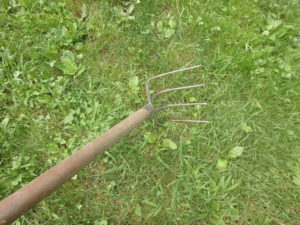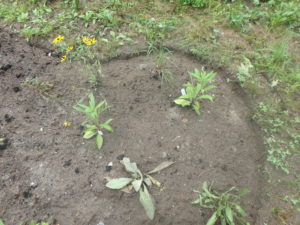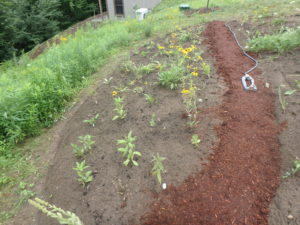Creating a Pollinator Garden
I recently helped prepare and plant a pollinator garden. Bees, butterflies and other insects need pollen and nectar for food, and suitable native plants on which to rest and lay their eggs. Unfortunately, many landscape plants have been introduced from foreign shores, and the plants may be less interesting to our native pollinators, or have less food value. A good pollinator garden is stocked with native plants for best results.
There certainly are plenty of seed mixes available to plant a “Meadow BURSTING WITH COLOR all summer long!” Unfortunately, seed mixes are not as easy to use as you might think. I know people who have rototilled or plowed a space, spread seed and been disappointed after year one.
After the first year, a few plants will dominate, and some of your favorites will disappear – because you often get a lot of annual flower seeds in a mix that will bloom in year one, but depend on self-sowing to come back in later years, and that doesn’t always happen.
So if you wish to have a healthy pollinator garden with plants that come back year after year, buy perennial plants from a knowledgeable source of native pollinator plants. This can be expensive, but doesn’t have to be. Most perennials at a garden center cost $8 to $15 a pot – and true natives are often hard to find.
We bought a mix of first-year perennial wildflowers in flats, each plant in a peat pot that is about 4 inches deep and 3 inches wide – for less than $5 a plant. We got ours from Northeast Pollinator Plants (NEPP) in Fairfax, Vermont. (www.northeastpollinator.com). They also sell individual plants, including common milkweed for monarch butterflies.
Why pick true natives? They co-evolved with our native insects. A named perennial cultivar often has brighter colors or more petals than a native of the same species – which may affect how our insects are attracted to it, or what they get from it. Timing is important to pollinators, too, and cultivated plants may bloom earlier or later than true natives.
I don’t recommend trying to rip out all your lawn and turning it into a pollinator garden all at once. That’s too much work. Four hundred square feet is a good size to start with – roughly 20 by 20 feet. We didn’t want a square, so we used 80 feet of garden hose (which would enclose a 20 foot square) and created an irregular, curvy shape with the hose. Then, using an edging tool, we cut the border of the space.
We removed all the grasses and weeds in that 400 foot garden space. It took 4 of us about 4 or 5 hours. We sliced through the grass and weeds with shovels, tipping the shovels back and loosening the soil. Then we used either a CobraHead hand weeder, or an old fashioned potato rake to pull out the chunks of sod. For big tap-rooted weeds, we used a garden fork to loosen the roots before pulling. Because the soil was sandy, weeds pulled relatively easily.
Then came the fun part: planting. I spoke recently with Jane Sorensen of Northeast Pollinator Plants and River Berry Farm. Jane is co-owner of NEPP and a professor at UVM. According to Jane, it is important to resist the temptation to add compost, manure and especially fertilizer, even if the soil is very lean – devoid of the dark organic material that our veggies and cultivated flowers are given for best results. The wildflowers in our selection from NEPP do well in poor soil and get too tall and flop if given fertilizer or much compost.
We got 84 plants for the 400 square foot garden – roughly one plant for each 2 foot-by-2 foot space. I cut 2-foot sticks to remind us how far apart to space our plants. These little plants were mostly just a foot tall, but some will end up being 4 to 6 feet tall, and creating large clumps in the future.
We planted 10 species of perennials and one grass. Early plants included penstemon, purple cone flower and baptisia. Mid-season plants were anise hyssop, wild bergamot (Monarda fistulosa, a relative of the beebalm we all know), boneset (Eupatorium perfoliatum) and blazing star (Liatris spicata). For late blooming flowers we used NY Ironweed (Vernonia noveborancensis), sneezeweed (Helenium autumnale) and New England aster. We planted little bluestem, a grass beloved by pollinators. Most all of those are good for full sun to part shade.
Jane suggested planting wildflowers in groups of 3 to 5 plants. Many native bees, she said, like to work one species of flower before moving on, so don’t spread them out too far.
Although we love to clean up our gardens in the fall, Jane said it is best to let the wildflower stems stand all winter, then clean up in the spring. That allows native pollinators, or their eggs, to overwinter in the plant stems. She credited that idea to Annie White in a talk for the New England Wildflower Society. She also said to save the stalks, setting them aside after clean up – so that eggs can hatch. Wait until you have had at least 3 consecutive days over 50 degrees in the spring before cleaning up.
Think about adding native wildflowers to your property, even if you don’t dedicate a huge swath to it. Plants used for pollinators may not be as showy as peonies and roses, but the bumblebees and butterflies they attract will be the icing on your cake.
Read Henry’s blog at https://dailyuv.com/





